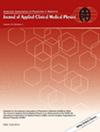Comprehensive clinical evaluation of novel 4DCT-based lung function imaging methods
Abstract
Purpose
Methods have been developed that apply image processing to 4DCTs to generate 4DCT-ventilation/perfusion lung imaging. Traditional methods for 4DCT-ventilation rely on Hounsfield-Unit (HU) density-change methods and suffer from poor numerical robustness while not providing 4DCT-perfusion data. The purpose of this work was to evaluate the clinical differences between classic HU-based 4DCT-ventilation approaches and novel 4DCT-ventilation/perfusion approaches.
Methods
Data from 63 lung cancer patients enrolled in a functional avoidance clinical trial were analyzed. 4DCT-data were used to generate four lung-function images: (1) classical HU-based 4DCT-ventilation (“4DCT-vent-HU”), and three novel, statistically robust methods: (2) 4DCT-ventilation based on the Mass Conserving Volume Change (“4DCT-vent-MCVC”), (3) 4DCT-ventilation using the Integrated Jacobian Formulation, and (4) 4DCT-perfusion. A radiologist reviewed all images for ventilation/perfusion defects (scored as yes/no) and the scores for the novel approaches were compared to those of 4DCT-vent-HU using receiver operating characteristic (ROC) analysis. Functional contours were generated using thresholding methods, and the contours from the three novel 4DCT-ventilation methods were compared against that from 4DCT-vent-HU (Dice similarity coefficients [DSC]). Functional mean lung dose (fMLD) and dose-function metrics were compared against dose-function metrics using 4DCT-vent-HU.
Results
ROC analysis revealed accuracy in the range of 0.55 to 0.73 comparing radiologist interpretations of 4DCT-vent-HU against the three novel approaches. Average DSC values were 0.41 ± 0.19, 0.44 ± 0.16, and 0.42 ± 0.17 comparing 4DCT-vent-HU to 4DCT-vent-IJF, 4DCT-vent-MCVC, and 4DCT-perf, respectively. All novel imaging methods showed significant differences (p < 0.01) in dose-function metrics compared to those of 4DCT-vent-HU. 4DCT-vent-MCVC and 4DCT-Perf depicted the smallest and largest differences from 4DCT-vent-HU in fMLD (3.51 ± 3.20 Gy and 5.90 ± 5.29 Gy, respectively).
Conclusion
This is the first work to comprehensively compare novel 4DCT-ventilation/perfusion methods against classical formulations. Our data show that significant differences between the 4DCT-based functional imaging methods exist, suggesting that studies are needed to evaluate which methods provide the most robust clinical results.

 求助内容:
求助内容: 应助结果提醒方式:
应助结果提醒方式:


